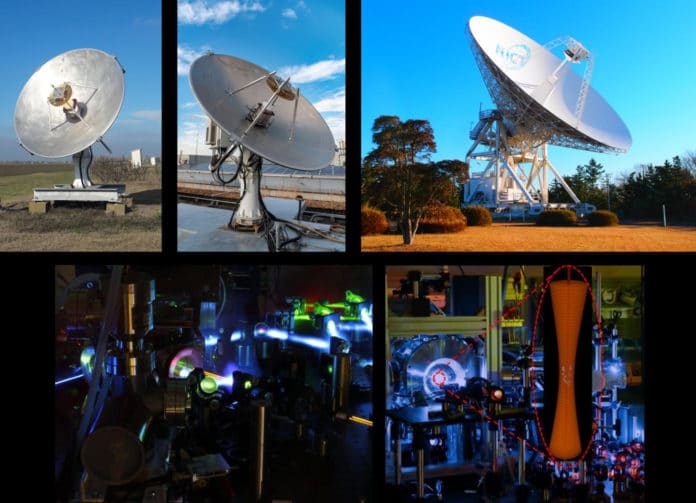The comparison of distant atomic clocks is foundational to international timekeeping, global positioning, and fundamental physics tests. Optical-fiber links allow the most precise optical clocks to be compared, without degradation, over intracontinental distances. But, intercontinental comparisons remain limited by the performance of satellite transfer techniques.
Now, scientists used radio telescopes observing distant stars to connect optical atomic clocks on different continents. Here, highly-energetic extragalactic radio sources replace satellites as the source of reference signals.
The study was conducted in an international collaboration between 33 astronomers and clock experts at the National Institute of Information and Communications Technology (NICT, Japan), the Istituto Nazionale di Ricerca Metrologica (INRIM, Italy), the Istituto Nazionale di Astrofisica (INAF, Italy), and the Bureau International des Poids et Mesures (BIPM, France).
The BIPM in Sèvres near Paris routinely calculates the international time recommended for civil use (UTC, Coordinated Universal Time) from the comparison of atomic clocks via satellite communications. However, the satellite connections essential to maintaining a synchronized global time have not kept up with the development of new atomic clocks: optical clocks that use lasers interacting with ultracold atoms to give a very refined ticking.
Gérard Petit, a physicist at the Time Department at BIPM, said, “To take the full benefit of optical clocks in UTC, it is important to improve worldwide clock comparison methods.”
The group of SEKIDO Mamoru at NICT designed two special radio telescopes, one deployed in Japan and the other in Italy, to realize the connection using the technique of Very Long Baseline Interferometry (VLBI). These telescopes are capable of observations over a large bandwidth, while antenna dishes of just 2.4-meter diameter keep them transportable.
SEKIDO said, “We want to show that broadband VLBI has the potential to be a powerful tool not only for geodesy and astronomy but also for metrology. To reach the required sensitivity, the small antennas worked in tandem with a larger 34 m radio telescope in Kashima, Japan, during the measurements taken from October 14, 2018, to February 14, 2019. These were among the last observations for the Kashima radio telescope before typhoon Faxai irreparably damaged the telescope in September 2019.”
Through this study, scientists aimed to connect two optical clocks in Italy and Japan, separated by a baseline distance of 8700 km. These clocks load several ultra-cold atoms in an optical lattice. The clocks utilize diverse atomic species: ytterbium for the clock at INRIM and strontium at NICT. Both are candidates for a future redefinition of the second in the International System of Units (SI).
Davide Calonico, head of the “Quantum Metrology and Nanotechnology” division and coordinator of the research at INRIM, said, “Today, the new generation of optical clocks is pushing to review the definition of the second. The road to a redefinition must face the challenge of comparing clocks globally, at the intercontinental scale, with better performances than today.”
IDO Tetsuya, director of the “Space-Time Standards Laboratory” and coordinator of the research at NICT, said, “The connection is possible by observing quasars billions of light-years away: radio sources powered by black holes weighing millions of solar masses, but so distant that they can be considered fixed points in the sky. The telescopes aim at a different star every few minutes to compensate for the effects of the atmosphere. We observed the signal not from satellites, but cosmic radio sources. VLBI may allow us in Asia to access the UTC relying on what we can prepare by ourselves.”
SEKIDO said, “Antennas like the transportable ones used in these measurements can be installed directly at the laboratories developing optical clocks around the world. A global optical clock network connected by VLBI may be realized by collaboration between the international communities of metrology and geodesy, just like the broadband VLBI network of the VLBI Global Observing System (VGOS) has already been established.”
Petit commented: “waiting for long-distance optical links, this research shows that there is still to gain from radio links, where VLBI with transportable antennas can complement the Global Navigation Satellite Systems and telecommunication satellites.”
Journal Reference:
- Pizzocaro, M., Sekido, M., Takefuji, K. et al. Intercontinental comparison of optical atomic clocks through very long baseline interferometry. Nat. Phys. (2020). DOI: 10.1038/s41567-020-01038-
